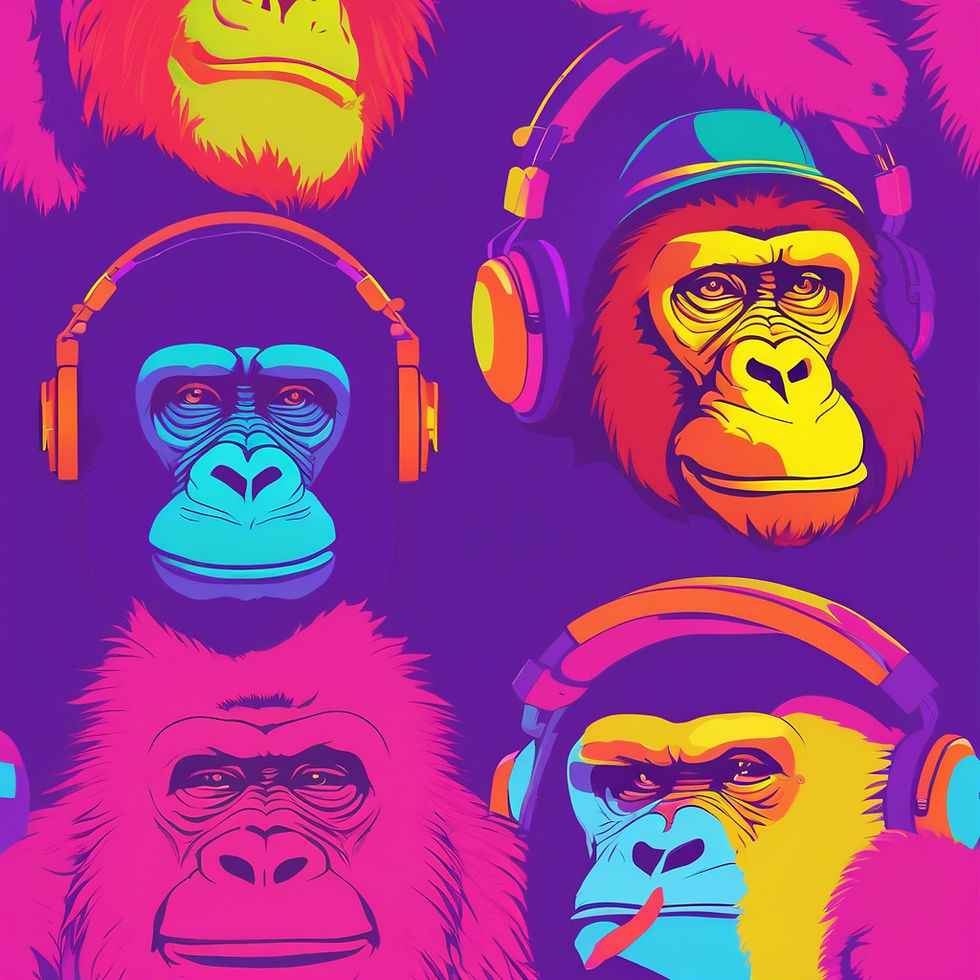Will Language Learning Apps Survive the Rise of Real-Time Translation?
- Attia Jamil

- Jun 2
- 6 min read
Updated: Jun 14

The Tower of Babel, Rebuilt by AI?
🔍 In This Blog, You’ll Discover:
How language learning apps like Duolingo, Memrise, and Babbel are evolving
The real impact of real-time translation tools like Google’s AR glasses
Why linguists are still critical in the age of AI
How different regions may adopt or resist this tech revolution
What edtech companies should do to stay relevant
The surprising cognitive benefits of learning a language, even in an AI-driven world
Imagine slipping on a pair of glasses and instantly understanding any language spoken around you. Thanks to advancements in AI and augmented reality, this sci-fi scenario is becoming a reality. Google's latest AR glasses, powered by Gemini AI, can translate multiple languages in real-time, displaying subtitles directly within the user's field of vision.
This is no longer just the domain of Star Trek's Universal Translator. This is real, tangible tech that might soon become as ubiquitous as smartphones. Yet with every leap in convenience comes a question of consequence.
With such technology, the question arises: Will traditional language learning apps become obsolete? Or will they adapt and thrive in this new landscape? Are we heading towards a world where linguistic knowledge is outsourced entirely to tech, or will the human touch still matter?
The Current Landscape of Language Learning Apps
🌍 State of the Language Learning Market (2024–2025)
🏷️ 2024 Market Size: $6.34B
📈 2025 Forecast: $7.36B
🌏 Top Growth Regions: Asia-Pacific, Latin America
👥 Key User Trends: Hybrid learning, AI-assisted tools, cultural immersion
The language learning app market has experienced significant growth, valued at approximately USD 6.34 billion in 2024 and projected to reach USD 7.36 billion in 2025. This growth is driven by the increasing demand for convenient and accessible language learning solutions, especially as globalisation and digital nomadism become the norm.
Top players in this space include:
Duolingo
Babbel
Memrise
Busuu
Rosetta Stone
Each of these apps has carved out its niche. Duolingo excels in gamification and bite-sized lessons. Memrise uses a unique pedagogy that starts with learning essential words and phrases, then immerses you in real-world scenarios where you actively use what you've learned. By practising with native speaker videos and realistic conversations, you’re able to communicate naturally—just as if you were living in the country. Babbel leans into grammar and structure, while Rosetta Stone focuses on immersive methods. Busuu throws community learning into the mix, allowing users to correct and assist one another.
Together, they reflect a diverse ecosystem, one where learners choose paths based on goals, time, and commitment. But is this a luxury that will survive the AI onslaught?
The Rise of Real-Time Translation Technology
Real-time translation tools are revolutionising communication by enabling seamless, instant translation across different languages. Google’s AR glasses, for instance, can translate multiple languages instantly, displaying subtitles directly within the user's field of vision. Imagine standing in a market in Tokyo, bargaining for sushi-grade tuna without knowing a word of Japanese – yet understanding every nuance.
Even more accessible tools, like smartphone-based apps (Google Translate, Microsoft Translator), are becoming increasingly powerful, with offline capabilities, voice detection, and AI-improved accuracy. Combined with wearables and smart devices, they bring translation to the fore of human interaction.
Such advancements raise questions about the necessity of traditional language learning methods. If tech can bridge the gap instantly, why spend months memorising verbs?
But tech, clever as it is, has its limits.
Duolingo's AI-First Strategy and Backlash
Duolingo, the undisputed king of quirky owls and passive-aggressive push notifications, recently made headlines with its bold "AI-first" pivot. CEO Luis von Ahn announced sweeping changes, where AI would not just assist but potentially replace much of the app's content development and even some human roles.
Cue the internet outrage.
Users revolted. TikTok turned hostile. The green owl – once a symbol of cheeky encouragement – became a meme villain. Critics accused the company of prioritising automation over humanity, gutting the very community that made it popular.
To be fair, Duolingo clarified that it wasn’t going full Skynet. Humans would still have roles – especially in reviewing and refining AI-generated content. But the tone-deaf announcement and the timing (on the heels of great financial results) painted a picture of corporate coldness. The backlash served as a masterclass in how not to announce sweeping AI changes.
The Role of Linguists in the AI Era
One group that stands to benefit? Linguists.
Training an LLM (Large Language Model) to understand idioms, sarcasm, regional dialects, and grammatical exceptions is no easy feat. Enter the human expert. Linguists are critical in labelling data, flagging errors, identifying cultural missteps, and fine-tuning AI outputs.
Language is messy. It evolves. It embodies history, emotion, and unspoken context. Machines can process rules, but meaning? That takes nuance. And nuance demands human insight.
We expect demand for linguists and language specialists to grow – not shrink – as companies realise the competitive advantage of culturally competent AI. Especially in regions with less digitised languages, local experts will be essential to ensure inclusivity and equity.
A Global View: Where Will Real-Time Translation Take Hold First?
Real-time translation's impact won't be uniform across the globe. Developed nations with access to fast networks, smartphones, and AR devices (like the US, Japan, Germany, South Korea) will be early adopters. Business travellers, tech-savvy tourists, and global teams will lap it up.
But what about emerging markets? Here, translation tech might leapfrog traditional learning. In regions with underfunded schools and language barriers to global participation, AR and AI tools could provide unprecedented access.
That said, some users – particularly in countries like France, Japan, or South Korea – have strong cultural attachments to language purity. In these places, learning the language isn't just practical – it's a rite of passage. The demand from cultural purists, educators, and professionals will sustain traditional learning.
The Psychological and Cognitive Case for Learning a Language
Learning a language isn’t just about chatting in cafes. It's a cognitive workout. Studies show bilinguals have improved memory, multitasking, and problem-solving skills. It builds empathy, patience, and global awareness.
And let’s not forget identity. Language is a gateway to belonging. Whether it's reading poetry in Urdu, watching K-dramas without subtitles, or negotiating in Swahili, language allows deeper connection than any AR overlay.
Real-time translation is transactional. Learning is transformational.
Strategic Moves: What Should EdTech Companies Do Now?
If you're an edtech startup or an established player, the time to act is now.
1. Partner, don’t panic. Google, Meta, and other giants are building the platforms. Smaller players should explore integration partnerships, licensing deals, or tech collaborations.
2. Embrace hybrid models. Use AI to support learners – not replace them. Suggest AR translation tools as aids for immersion practice. Help learners compare auto-translated phrases with correct ones.
3. Focus on depth. Instead of racing to cover more languages, edtech firms could offer cultural insights, dialectal variations, and real-life application scenarios that AR can’t replicate.
4. Highlight human connection. Lean into the psychology of language learning – build community, mentorship, live tutors, and native speaker conversations.
Conclusion: Embracing a Bilingual Future
🐒 "Translation is a shortcut. Learning is a journey. And we love the scenic route." — Agile Goes Ape
The advent of real-time translation technology presents both challenges and opportunities for the language learning industry. While it may diminish the necessity for casual learners to invest time in language acquisition, it also opens avenues for integrating AI tools into educational platforms, enhancing the learning experience.
Language learning apps must adapt by incorporating AI features, emphasising cultural insights, and targeting users who seek more than just transactional communication. Language is a living, breathing thing. Let’s keep it that way.
FAQs
Some answers to questions that have been asked and shared here:
Q1: Will real-time translation tools eliminate the need to learn new languages? Not entirely. While they facilitate immediate communication, they lack the depth of understanding and cultural nuance that comes with learning a language.
Q2: How are language learning apps adapting to AI advancements? Many are integrating AI to personalise learning experiences, automate content creation, and provide real-time feedback to users.
Q3: What is the role of linguists in developing AI translation tools? Linguists are crucial for training AI models, ensuring translations are accurate, culturally appropriate, and contextually relevant.
Q4: Could tech replace human translators at institutions like the UN? Not anytime soon. High-stakes diplomacy relies on precision, context, and emotion – areas where AI still falters.
Q5: What do users want from language tech? Convenience, yes – but also learning. Many users still want to understand, not just translate. The future might be hybrid: tech to assist, humans to connect.
What do you want from the future of language learning?
Drop us your thoughts — tech, teachers, or something in between?
References
Travel In Your Own Way. "Google Unveils Smart Glasses With Real-Time Translation and Navigation for Travelers." https://travelinyourownway.com/2025/05/22/google-unveils-smart-glasses-with-real-time-translation-and-navigation-for-travelers/
Straits Research. "Language Learning Apps Market Forecast (2024-2025)." https://straitsresearch.com/report/language-learning-apps-market
WebProNews. "Duolingo Backtracks on AI Strategy After User Backlash." https://www.webpronews.com/duolingo-backtracks-on-ai-strategy-after-user-backlash
TechRepublic. "Duolingo Faces Backlash on AI Strategy." https://www.techrepublic.com/article/news-duolingo-ai-strategy-backlash
Lionbridge. "Why We Need Human-in-the-Loop AI Translation." https://www.lionbridge.com/blog/translation-localization/why-we-need-human-in-the-loop-ai-translation
Lion People Global. "The Growing Importance of Linguists in AI." https://lionpeopleglobal.com/the-growing-importance-of-linguists-in-ai










Comentarios